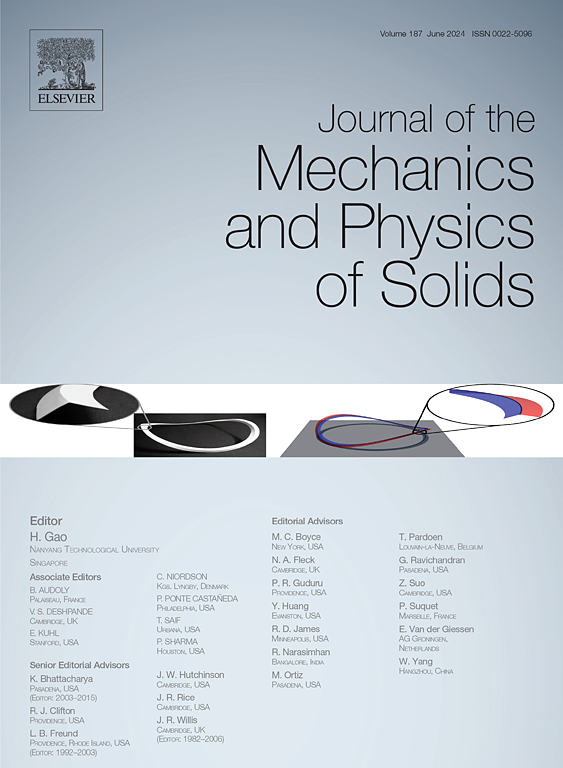广义标准材料的相场断裂公式:热力学与损伤的相互作用
IF 6
2区 工程技术
Q2 MATERIALS SCIENCE, MULTIDISCIPLINARY
引用次数: 0
摘要
由于延性材料断裂过程的多物理场特性,对其进行精确的断裂建模是计算力学领域的一个挑战。将热力学和损伤之间的相互作用整合到韧性断裂模型中对于预测临界破坏模式至关重要。在本文中,我们开发了一个通用的相场(PF)框架来模拟韧性断裂,考虑了有限应变弹塑性。该框架源于广义标准材料(gsm)本构关系的变分公式,其响应由亥姆霍兹自由能和耗散伪势描述。它的变分结构是基于一个函数的最小值原理,该函数表示可逆和不可逆过程的功率密度之和。通过对von Mises屈服函数的约束最小化该泛函,推导出等效塑性应变的演化方程和关联流动规律。这一约束优化问题对一类广泛的热粘塑性模型进行了解析求解。当前工作的关键创新包括(i)考虑非消失损伤相关屈服应力的三次塑性退化函数,(ii)三种热粘塑性模型的亥姆霍兹自由能和耗散伪势的封闭形式表达式,(iii)具有非线性硬化规律的扩展Johnson-Cook塑性模型,以及(iv)依赖于塑性退化函数和变量Taylor-Quinney (TQ)系数的塑性功热源。通过包括Sandia裂缝挑战在内的四个韧性裂缝问题,测试了该框架的性能。在这些问题中,除了力-位移曲线量化的整体结构响应外,我们还研究了相关场变量的演变,如PF阶参数、等效塑性应变、温度和内部功耗密度。数值研究表明,该框架能有效表征韧性断裂,计算结果与实验数据吻合较好。本文章由计算机程序翻译,如有差异,请以英文原文为准。
A phase-field fracture formulation for generalized standard materials: The interplay between thermomechanics and damage
Accurately modeling fracture of ductile materials poses open challenges in the field of computational mechanics due to the multiphysics nature of their failure processes. Integrating the interplay between thermodynamics and damage into ductile fracture models is vital for predicting critical failure modes. In this paper, we develop a versatile phase-field (PF) framework for modeling ductile fracture, taking into account finite-strain elasto-plasticity. The framework stems from a variational formulation of constitutive relations for generalized standard materials (GSMs), whose response is described by a Helmholtz free energy and a dissipation pseudo-potential. Its variational structure is based on a minimum principle for a functional that expresses the sum of power densities for reversible and irreversible processes. By minimizing this functional with a constraint on a von Mises yield function, we derive the evolution equation for the equivalent plastic strain and an associative flow rule. This constrained optimization problem is analytically solved for a wide class of thermo-viscoplasticity models. The key innovations of the current work include (i) a cubic plastic degradation function that accounts for a non-vanishing damage-dependent yield stress, (ii) closed-form expressions of the Helmholtz free energy and dissipation pseudo-potential for three thermo-viscoplasticity models, (iii) an extended Johnson–Cook plasticity model with a nonlinear hardening law, and (iv) a plastic work heat source that depends on the plastic degradation function and a variable Taylor–Quinney (TQ) coefficient. The capabilities of the proposed framework are tested with the aid of four ductile fracture problems, including the Sandia Fracture Challenge. In each of these problems, we examine the evolution of relevant field variables such as the PF order parameter, the equivalent plastic strain, the temperature, and the internal power dissipation density, in addition to the overall structural response quantified by the force–displacement curve. These numerical studies demonstrate that the proposed framework effectively represents ductile fracture, yielding computational results that exhibit good agreement with experimental data.
求助全文
通过发布文献求助,成功后即可免费获取论文全文。
去求助
来源期刊
CiteScore
9.80
自引率
9.40%
发文量
276
审稿时长
52 days
期刊介绍:
The aim of Journal of The Mechanics and Physics of Solids is to publish research of the highest quality and of lasting significance on the mechanics of solids. The scope is broad, from fundamental concepts in mechanics to the analysis of novel phenomena and applications. Solids are interpreted broadly to include both hard and soft materials as well as natural and synthetic structures. The approach can be theoretical, experimental or computational.This research activity sits within engineering science and the allied areas of applied mathematics, materials science, bio-mechanics, applied physics, and geophysics.
The Journal was founded in 1952 by Rodney Hill, who was its Editor-in-Chief until 1968. The topics of interest to the Journal evolve with developments in the subject but its basic ethos remains the same: to publish research of the highest quality relating to the mechanics of solids. Thus, emphasis is placed on the development of fundamental concepts of mechanics and novel applications of these concepts based on theoretical, experimental or computational approaches, drawing upon the various branches of engineering science and the allied areas within applied mathematics, materials science, structural engineering, applied physics, and geophysics.
The main purpose of the Journal is to foster scientific understanding of the processes of deformation and mechanical failure of all solid materials, both technological and natural, and the connections between these processes and their underlying physical mechanisms. In this sense, the content of the Journal should reflect the current state of the discipline in analysis, experimental observation, and numerical simulation. In the interest of achieving this goal, authors are encouraged to consider the significance of their contributions for the field of mechanics and the implications of their results, in addition to describing the details of their work.

 求助内容:
求助内容: 应助结果提醒方式:
应助结果提醒方式:


